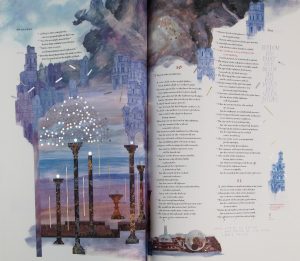 Proverbs 9 begins, “Wisdom has built her house, she has hewn her seven pillars.” That verse is unfortunately not visible on this page, but we do see Wisdom’s pillars, of varying heights and widths. Fabric and lace render marble veins, and each pillar is topped with a pearl (of wisdom?), “a precious thing of beauty created by mysterious processes,” suggests Susan Sink in The Art of the Saint John’s Bible, vol. 2, p. 24. The pearls appear to have descended from the stamp just about them, with an echo in the swirling clouds — the same stamp we saw in the Revelation Frontispiece, based on a piece of cloth from India that was embroidered and appliquéd with mirrors.
Proverbs 9 begins, “Wisdom has built her house, she has hewn her seven pillars.” That verse is unfortunately not visible on this page, but we do see Wisdom’s pillars, of varying heights and widths. Fabric and lace render marble veins, and each pillar is topped with a pearl (of wisdom?), “a precious thing of beauty created by mysterious processes,” suggests Susan Sink in The Art of the Saint John’s Bible, vol. 2, p. 24. The pearls appear to have descended from the stamp just about them, with an echo in the swirling clouds — the same stamp we saw in the Revelation Frontispiece, based on a piece of cloth from India that was embroidered and appliquéd with mirrors.
The chapter continues, “She has slaughtered her animals, she has mixed her wine, she has also set her table.” Note that the artist has provided a set table, spread with wine but bread substitutes for meat. This and verse 5 of the chapter, “Come, eat of my bread and drink of the wine I have mixed,” could be seen as a connection between Wisdom and Christ, in making the viewer think of Christ’s invitation to “take this bread” and “drink this wine, and the fellowship of the Eucharistic prayer (Sink, vol. 3, p. 25).
A whole village of buildings appears to sprout from one of the pillars, including apparently a “monochromatic green drawing of the dome of the church at Saint Benedict’s Monastery (Sink, vol. 3, p. 24),” a sister site to Saint John’s Monastery. This also is echoed in the passage’s next verse: “She has sent out her servant-girls, she calls from the highest places in the town.” Faint architectural images vanish into the clouds above; wisdom remains while man’s creations subside.
For all engaged in life-long learning and dedicated to a mindful life, Proverbs 9:6 is especially apt: “Lay aside immaturity, and live, and walk in the way of insight.”